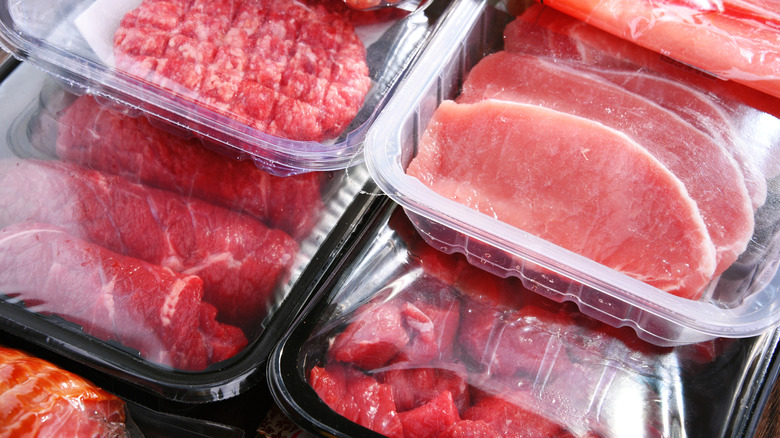The Special Packaging That Makes Grocery Store Steaks Last Longer
When you pick up a steak from the grocery store, you typically either grab it from the butcher's counter or the cases located in the same area. If you get it from the butcher, they will wrap it up in paper, seal it with tape, and drop it into a plastic bag. When you pick it up from the case, the type of packaging the steak will likely be sitting in is a small plastic tray with a heat-sealed film. And while one can be forgiven for assuming the extra attention from the butcher would take the prize for freshness, it's actually the sealed tray that will make your steak last longer once you pop it in the fridge.
This is because it's known as MAP or modified atmosphere packaging, and it alters the composition of the air under the heat-sealed plastic film by adding gases. Manufacturers pump in a mix of carbon dioxide and/or nitrogen and possibly small amounts of carbon monoxide (up to 4.5% by volume, per the FDA). This differs from breathable air and has been formulated to slow down spoilage and extend the shelf-life of steak.
This is not to be mistaken for other cuts packaged with air, like the loosely wrapped, styrofoam tray variety. These are done by hand, often within the grocery store, and don't contain these gases. and The telltale sign that it's modified atmospheric packaging is that you could bounce a quarter off of the tight film.
How long will the steak last and is it safe?
Specifically, the carbon dioxide in modified atmosphere packaging mitigates the growth of mold, yeasts, and other microorganisms. This was a true innovation for grocers, as it dramatically extended the shelf-life of fresh foods. Beef, in particular, went from being shelf-safe for four days in traditional packaging to roughly 12 using MAP containers.
While this packaging reduces the use of artificial preservatives and stabilizers in meats, one downside is that it works so well, it can keep steak bright red well past the date at which it's safe to consume. Carbon monoxide has an effect on the pigments in beef that help it maintain its red color well after it has spoiled — for possibly 20 days or more. Meanwhile, that steak sitting out in the butcher's case would start to show signs of spoilage within a handful of days. This is something to keep in mind when shopping in the pre-wrapped meat section. Don't go by color alone — check the use-by date and look for other signs of bacterial growth, such as bloated packaging.

